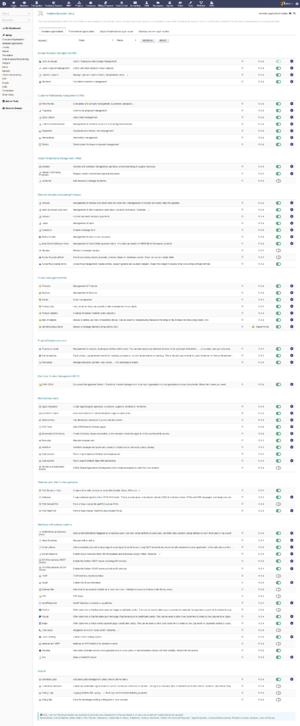First setup
After completing the initial installation, you must configure parameters in Dolibarr to match your needs.
Company/Organization
The first mandatory step is to define your company/organization information. For this, from home page, choose menu "Home->Setup->Company/Organization" and add the information for your company/organization.
- Name: Name of your company/organization
- Logo: Add here a logo of your company (.png, .jpg or .gif). It can accept any size but it is recommended to use a logo with 130 pixels height and up to 800 pixels width. Here is a little scheme on what will be the result on the PDF. The recommended format is png with NO transparent layer (Dolibarr uses FPDF that does not support this format).
- Logo (squared): Add here your squared logo (.png or .jpg) that will be used in the top right corner of the application
- Fiscal Year: Define your starting month of yiscal Year
- Country: Define your country: other options depend on this selection.
- Sales Tax (VAT) Management: Define how you manage Sales Tax (or not).
- Second type of tax: Define if you would like to use second type of taxe (or not).
- Third type of tax: Define if you would like to use third type of taxe (or not).
Modules
The activation of modules is the second mandatory step. Which modules you will activate depends on what you want to do with Dolibarr. In most cases, you may want to use all modules. You have to activate each module one by one. For example, to manage a company, you might activate at least modules Third party, Invoices, and Products, but probably many more.
To activate a module, go to page "Home->Setup->Modules" and click the button 'on/off' in the "Status" column to enable it.
The list of standard modules is defined on page List of Modules.
If you are unsure of the function of a module, you may activate it and see what new menu item appears in Dolibarr (the horizontal bar), also after activating a module, check that you grant to yourself permissions on new features that were enabled. You can activate or deactivate a module when you want.
Once a module has been activated, it may need further configuration (click on the setup icon that appears on the right of module line if a module needs its own setup). See documentation of module for more information.
Menus
Choose here which menu manager you want to use for internal and external users. The menu manager changes the labels, orders and organization of the left and top menus. See page Menus system for more information.
Display
On this page, you can set the default language of application and the look and feel of screens. In a first use, you can keep everything with default values.
Note: Activating multilanguage option will allow you to be able to set the preferred language of customers, to print their Invoice/Proposal/Order in their own language. Product translations will also be available.
Other (Widgets, Alerts, Security, Limits and accuracy, Emails, SMS, Dictionary setup...)
Other entries in Setup menu are advanced options. You can ignore them if you want.
- Setup Widgets
- Setup Alerts
- Setup Security
- Setup Limits and accuracy
- Setup PDF
- Setup EMails
- Setup SMS
- Setup Dictionary
- Setup Other
Users
The last step is to create users and assign permissions. Almost all the modules even activated earlier, are not accessible if you do not give permissions. To do this, you can go to the menu Home -> Users & Groups to define users and their rights. Attention, you should consider to check and reset the user rights when you enable a new module. The list of rights available depends on the activated modules (see above). It is recommended to configure permissions after activating the modules you want to use. For certain actions, if you do not have the rights to do an action, Dolibarr will not show you the action. You might miss some useful or important features. To give rights to a user or yourself, if you are an administrator, go to Home -> Users & Groups, select the desired user, then click on its 'Permission' tab.
You can avoid these configuration steps for each newly created user, by configuring the default rights (understand rights allocated automatically each time a new user created) by configuring the default permissions on the menu Setup Security.

